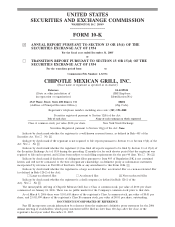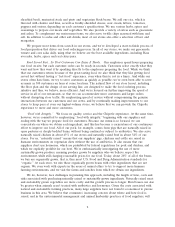Chipotle 2005 Annual Report Download - page 15
Download and view the complete annual report
Please find page 15 of the 2005 Chipotle annual report below. You can navigate through the pages in the report by either clicking on the pages listed below, or by using the keyword search tool below to find specific information within the annual report.existing infrastructure. We also place a lot of importance on our culture, which we believe has been an
important contributor to our success. As we grow, however, we may have difficulty maintaining our
culture or adapting it sufficiently to meet the needs of our operations. Our failure to manage our
growth effectively could harm our business and operating results.
New stores, once opened, may not be profitable, and the increases in average store sales and comp store
sales that we’ve experienced in the past may not be indicative of future results.
Historically, our new stores have opened with an initial ramp-up period typically lasting 24 months
or more, during which they generated sales and income below the levels at which we expect them to
normalize. This is in part due to the time it takes to build a customer base in a new market, higher
fixed costs relating to increased construction and occupancy costs and other start-up inefficiencies that
are typical of new stores. New stores may neither be profitable nor have results comparable to our
existing stores. In addition, our average store sales and comp store sales, which we define as the change
in period-over-period sales for the comparable store base which includes company-operated stores
opened for at least 13 months, likely will not continue to increase at the rates achieved over the past
several years. Our ability to operate new stores profitably and increase average store sales and comp
store sales will depend on many factors, some of which are beyond our control, including:
• executing our vision effectively;
• initial sales performance of new stores;
• competition, either from our competitors in the restaurant industry or our own stores;
• changes in consumer preferences and discretionary spending;
• consumer understanding and acceptance of the Chipotle experience;
• road construction and other factors limiting access to new stores;
• general economic conditions, which can affect store traffic, local labor costs and prices we pay
for the ingredients and other supplies we use; and
• changes in government regulation.
If we fail to open stores as quickly as planned, or if new stores don’t perform as planned, our
business and future prospects could be harmed. In addition, changes in our average store sales or comp
store sales could cause our operating results to vary adversely from expectations, which could cause the
price of our common stock to fluctuate substantially.
Our expansion into new markets may present increased risks due to our unfamiliarity with those areas.
Some of our new stores are planned for markets where we have little or no operating experience.
Those markets may have different competitive conditions, consumer tastes and discretionary spending
patterns than our existing markets. As a result, those new stores may be less successful than stores in
our existing markets. Consumers in a new market may not be familiar with the Chipotle brand, and we
may need to build brand awareness in that market through greater investments in advertising and
promotional activity than we originally planned. We may find it more difficult in new markets to hire,
motivate and keep qualified employees who can project our vision, passion and culture. Stores opened
in new markets may also have lower average store sales than stores opened in existing markets, and
may have higher construction, occupancy or operating costs than stores in existing markets. What’s
more, we may have difficulty in finding reliable suppliers or distributors or ones that can provide us,
either initially or over time, with adequate supplies of ingredients meeting our quality standards. Sales
at stores opened in new markets may take longer to ramp up and reach expected sales and profit
levels, and may never do so, thereby affecting our overall profitability.
9
























